STL容器之vector
【1】模板类vector
模板类vector可理解为广义数组。广义数组,即与类型无关的数组,具有与数组相同的所有操作。
那么,你或许要问:既然C++语言本身已提供了一个序列式容器array,为什么还要vector呢?
我们一直强调,事物总是朝向更先进的方向螺旋式发展与进化。这个问题其中的道理也不例外。
vector的数据安排及操作方式与array非常相似。两者唯一区别在于空间运用的灵活性。
array是静态空间,一旦配置不能改变。要想换个大(或小)点的房子,一切琐细得由客户端自己料理(步骤如下):
首先,配置一块新空间,然后从旧地址将元素逐一搬往新地址,最后把原来的空间释放还给系统。
vector是动态空间,不仅可以在运行期再确定容器容量大小,而且随着元素的加入,它的内部机制会自动扩充空间以容纳新元素。
所以,相比较array,运用vector对内存的合理灵活性利用有很大的帮助。
【2】vector应用实例
(1)有构造函数才会有容器。模板类vector的构造函数及构建实例。代码如下:
#include <iostream>
#include <vector>
#include <memory>
using namespace std; void main()
{
/* C++11
default (1)
explicit vector (const allocator_type& alloc = allocator_type());
// 构建一个空容器(默认构造函数)。 fill (2)
explicit vector (size_type n);
vector (size_type n, const value_type& val,
const allocator_type& alloc = allocator_type());
// 构建一个容器。容器存储n个元素,每个元素的初始值为val(如果提供)。 range (3)
template <class InputIterator>
vector (InputIterator first, InputIterator last,
const allocator_type& alloc = allocator_type());
// 构建一个容器。容器存储元素与源容器中[first,last)区间的元素内容一样。
// 内容指存放元素的值及位置和[first,last)区间中完全一样,方向也要一致。 copy (4)
vector (const vector& x);
vector (const vector& x, const allocator_type& alloc);
// 拷贝构造函数。构建一个容器,逐个复制源容器x中的每一个元素,存放到本容器中,方向也保持一致。 move (5)
vector (vector&& x);
vector (vector&& x, const allocator_type& alloc);
// 移动构造函数。如果新的分配器alloc和x的分配器alloc不一样,那么将移动源容器x里面的元素到新的vector。
// 如果分配器是一样的,那么将直接转换其所有权。
// 将右值引用中容器x所有元素的所有权移动到新的vector中,避免付出昂贵的复制代价。 initializer list (6)
vector (initializer_list<value_type> il,
const allocator_type& alloc = allocator_type());
// 初始化列表构造函数。从初始化列表il中复制每一个元素,放到新的vector中,方向与列表保持一致。
*/
// default (1)
vector<int> vInt1; // fill (2)
int n;
cin >> n;
vector<int> vInt2(n); vector<int> vInt3(); vector<int> vInt4(, ); // range(3)
vector<int> vInt5(vInt4.begin(), vInt4.end()); int myInt[] = {, , , , };
vector<int> vInt6(myInt, myInt + sizeof(myInt) / sizeof(int)); // copy(4)
vector<int> vInt7(vInt4); // move(5)
vector<unique_ptr<string> > vUS = vector<unique_ptr<string> >({
unique_ptr<string> (new string("Qin")),
unique_ptr<string> (new string("Liu")),
unique_ptr<string> (new string("Wang")),
unique_ptr<string> (new string("Zhang"))}); // initializer_list(6)
vector<int> vInt8({, , , , });
}
对于任何一个类而言,构造函数是相当重要的,其所有对象呈现的操作方法都与构造函数息息相关。
类的构造函数为对象先天性的行为铺垫(比如:类的构造函数若多一个参数,那么类将会有很多成员方法为这个参数服务)。
下面的实例演示使用vector模板方便创建动态分配数组的优势(内置数组无法完成)
#include <iostream>
#include <vector>
#include <string>
using namespace std; void main()
{
cout << "请输入预处理学生数目:\n";
int nStudents;
cin >> nStudents;
vector<string> names(nStudents);
vector<int> scores(nStudents);
cout << "请输入" << nStudents << " 个学生的姓名和英语成绩 (0 ~ 100)。\n";
int i;
for (i = ; i < nStudents; ++i)
{
cout << "姓名 No" << i + << ": ";
cin >> names[i];
cout << "成绩 (0 ~ 100):";
cin >> scores[i];
cin.get();
}
cout << "输入所有学生信息结束。\n";
cout << "打印输入姓名及成绩如下:\n";
for (i = ; i < nStudents; ++i)
{
cout << names[i] << "\t" << scores[i] << endl;
} cin.get();
}
// Run out:
/*
请输入预处理学生数目:
5
请输入5 个学生的姓名和英语成绩 (0 ~ 100)。
姓名 No1: sun
成绩 (0 ~ 100):89
姓名 No2: li
成绩 (0 ~ 100):87
姓名 No3: wang
成绩 (0 ~ 100):90
姓名 No4: qin
成绩 (0 ~ 100):98
姓名 No5: zhang
成绩 (0 ~ 100):69
输入所有学生信息结束。
打印输入姓名及成绩如下:
sun 89
li 87
wang 90
qin 98
zhang 69
*/
vector模板更多的方法请看下节。
(2)常用成员方法应用示例如下代码:
#include <iostream>
#include <vector>
using namespace std; void printVectorValue(vector<int> & vInt)
{
for (vector<int>::iterator pt = vInt.begin(); pt != vInt.end(); ++pt)
{
cout << *pt << "\t";
}
cout << endl;
} void main()
{
// vector对象的常用方法以及应用示例如下:
cout << "动态构建一个整型容器(请输入整数值,0时退出):\n";
vector<int> vMyInts;
int nTemp;
while (cin >> nTemp && nTemp != )
{
vMyInts.push_back(nTemp);
}
cout << "您输入 " << vMyInts.size() << "个元素,分别如下: " << endl;
printVectorValue(vMyInts);
cout << "构建整型容器vMyInts完成" << endl << endl; //(1)a.assign(b.begin(), b.begin() + 3); // b为向量,将b的0~2个元素构成的向量赋给a
cout << "(1) assign方法 :" << endl;
vector<int> vA1;
vA1.assign(vMyInts.begin(), vMyInts.begin() + );
cout << "容器vA1元素如下:" << endl;
printVectorValue(vA1);
cout << "(1) assign方法应用示例完成。" << endl << endl; //(2)a.assign(4, 2); // 容器a只含4个元素,且每个元素值为2
cout << "(2) assign(4, 2)方法 :" << endl;
vector<int> vA2;
vA2.assign(, );
cout << "容器vA2元素如下:" << endl;
printVectorValue(vA2);
cout << "(2) assign(4, 2)方法应用示例完成。" << endl << endl; //(3)a.back(); // 返回容器a的最后一个元素
cout << "(3) back方法 :" << endl;
cout << "vMyInts容器的最后一个元素是:" << vMyInts.back() << endl;
cout << "(3) back方法应用示例完成。" << endl << endl; // (4)a.front(); // 返回容器a的第一个元素
cout << "(4) front方法 :" << endl;
cout << "vMyInts容器的最前一个元素是:" << vMyInts.front() << endl;
cout << "(4) front方法应用示例完成。" << endl << endl; // (5)a[i]; // 返回a的第i个元素,当且仅当a[i]存在
cout << "(5) a[i] 方法 :" << endl;
cout << "vMyInts容器的第2个元素是:" << vMyInts[ - ] << endl;
cout << "(5) a[i]方法应用示例完成。" << endl << endl; // (6)a.clear(); // 清空容器a中的元素
cout << "(6) clear() 方法 :" << endl;
cout << "清空前,vA2容器中的元素为: " << endl;
printVectorValue(vA2);
vA2.clear();
cout << "清空后,vA2容器中的元素为: " << endl;
printVectorValue(vA2);
cout << "(6) clear()方法应用示例完成。" << endl << endl; // (7)a.empty(); // 判断容器a是否为空,空则返回ture,不空则返回false
cout << "(7) empty() 方法 :" << endl;
cout << "vA2容器是否为空:" << vA2.empty() << endl;
cout << "(7) empty()方法应用示例完成。" << endl << endl; // (8)a.pop_back(); // 删除容器a的最后一个元素
cout << "(8) pop_back() 方法 :" << endl; vA2.clear();
cout << "删除前,vMyInts容器中的元素为: " << endl;
printVectorValue(vMyInts);
vMyInts.pop_back();
cout << "删除最后一个元素后,vMyInts容器中的元素为: " << endl;
printVectorValue(vMyInts);
cout << "(8) pop_back()方法应用示例完成。" << endl << endl; // (9)a.erase(a.begin() + 1, a.begin() + 3);
// 删除容器a中第1个(从第0个算起)到第2个元素,也就是说删除的元素从[a.begin() + 1, a.begin() + 3)(前闭后开区间)
cout << "(9) erase() 方法 :" << endl; vA2.clear();
cout << "删除前,vMyInts容器中的元素为: " << endl;
printVectorValue(vMyInts);
vMyInts.erase(vMyInts.begin() + , vMyInts.begin() + );
cout << "删除后,vMyInts容器中的元素为: " << endl;
printVectorValue(vMyInts);
cout << "(9) erase()方法应用示例完成。" << endl << endl; // (10)a.push_back(5); // 在容器a的最后一个向量后插入一个元素,其值为5
cout << "(10) push_back() 方法 :" << endl; vA2.clear();
cout << "添加前,vMyInts容器中的元素为: " << endl;
printVectorValue(vMyInts);
vMyInts.push_back();
cout << "添加后,vMyInts容器中的元素为: " << endl;
printVectorValue(vMyInts);
cout << "(10) push_back()方法应用示例完成。" << endl << endl; // (11)a.insert(a.begin() + 1, 5);
// 在容器a的第1个元素(从第0个算起)的位置插入数值5,如a为1,2,3,4 插入元素后为1,5,2,3,4
cout << "(11) insert() 方法 :" << endl;
cout << "插入前,vMyInts容器中的元素为: " << endl;
printVectorValue(vMyInts);
vMyInts.insert(vMyInts.begin() + , );
cout << "插入后,vMyInts容器中的元素为: " << endl;
printVectorValue(vMyInts);
cout << "(11) insert()方法应用示例完成。" << endl << endl; // (12)a.insert(a.begin() + 1, 3, 5); // 在容器a的第1个元素(从第0个算起)的位置插入3个数,其值都为5
cout << "(12) insert() 方法 :" << endl;
cout << "插入前,vMyInts容器中的元素为: " << endl;
printVectorValue(vMyInts);
vMyInts.insert(vMyInts.begin() + , , );
cout << "插入后,vMyInts容器中的元素为: " << endl;
printVectorValue(vMyInts);
cout << "(12) insert()方法应用示例完成。" << endl << endl; // (13)a.insert(a.begin() + 1, b + 3, b + 6);
// b为数组。在a的第1个元素(从第0个算起)的位置插入b的第3个元素到第5个元素(不包括b + 6)
// b为1,2,3,4,5,9,8 插入元素后为1,4,5,9,2,3,4,5,9,8
cout << "(13) insert() 方法 (容器示例):" << endl;
cout << "插入前,vMyInts容器中的元素为: " << endl;
printVectorValue(vMyInts);
cout << "插入前,vA1容器中的元素为: " << endl;
printVectorValue(vA1);
vA1.insert(vA1.begin() + , vMyInts.begin() + , vMyInts.begin() + );
cout << "插入后,vMyInts容器中的元素为: " << endl;
printVectorValue(vMyInts);
cout << "插入后,vA1容器中的元素为: " << endl;
printVectorValue(vA1);
cout << "(13) insert()方法应用示例完成。" << endl << endl; cout << "(13) insert() 方法 (数组示例):" << endl;
cout << "插入前,vA1容器中的元素为: " << endl;
printVectorValue(vA1);
cout << "数组中的元素为: {1, 2, 3, 4, 5, 6}" << endl;
int nArrB[] = {, , , , , };
vA1.insert(vA1.begin() + , nArrB + , nArrB + );
cout << "插入后,vA1容器中的元素为: " << endl;
printVectorValue(vA1);
cout << "(13) insert()方法应用示例完成。" << endl << endl; // (14)a.size(); // 返回容器a中元素的个数;
cout << "(14) size() 方法: " << endl;
cout << "vA1容器中的元素为: " << endl;
printVectorValue(vA1);
cout << "vA1容器中元素个数为:" << vA1.size() << endl;
cout << "(14) size()方法应用示例完成。" << endl << endl; // (15)a.capacity(); // 返回容器a的容量
cout << "(15) capacity() 方法: " << endl;
cout << "vA1容器的容量为:" << vA1.capacity() << endl;
cout << "(15) capacity()方法应用示例完成。" << endl << endl; // (16)a.rezize(10); // 将a的现有元素个数调至10个,多则删,少则补,其值随机
cout << "(16) resize() 方法: " << endl;
cout << "重新分配大小前,vA1容器中元素为: " << endl;
printVectorValue(vA1);
vA1.resize();
cout << "vA1.resize(6) 重新分配大小后,vA1容器中元素为:" << endl;
printVectorValue(vA1);
cout << "(16) resize()方法应用示例完成。" << endl << endl; // (17)a.rezize(10, 2); // 将容器a的现有元素个数调至10个,多则删,少则补其值为2
cout << "(17) resize() 方法: " << endl;
cout << "重新分配大小前,vA1容器中元素为: " << endl;
printVectorValue(vA1);
vA1.resize(, );
cout << "vA1.resize(10, 110) 重新分配大小后,vA1容器中元素为:" << endl;
printVectorValue(vA1);
cout << "(17) resize()方法应用示例完成。" << endl << endl; // (18)a.reserve(100);
// 将容器a的容量(capacity)扩充至100,也就是说现在测试 a.capacity();的时候返回值是100。
// 这种操作只有在需要给a添加大量数据的时候才有意义,
// 因为这将避免内存多次容量扩充操作(当a的容量不足时电脑会自动扩容,当然这必然降低性能。)
cout << "(18) reserve() 方法: " << endl;
cout << "扩容前,vA1容器的容量为:" << vA1.capacity() << endl;
vA1.reserve();
cout << "扩容后,vA1容器的容量为:" << vA1.capacity() << endl;
cout << "(18) reserve()方法应用示例完成。" << endl << endl; // (19)a.swap(b); // b为容器,将a中的元素和b中的元素进行整体性交换
cout << "(19) swap() 方法: " << endl;
cout << "vA1容器中的元素为: " << endl;
printVectorValue(vA1);
cout << "vMyInts容器中的元素为: " << endl;
printVectorValue(vMyInts);
vA1.resize();
vMyInts.resize();
vA1.swap(vMyInts);
cout << "vA1容器中的元素为: " << endl;
printVectorValue(vA1);
cout << "vMyInts容器中的元素为: " << endl;
printVectorValue(vMyInts);
cout << "(19) swap() 方法应用示例完成。 " << endl << endl; // (20)a = b; // b为容器,将一个对象赋给另一个对象
cout << "(20) 赋值方法: " << endl;
cout << "vA1容器中的元素为: " << endl;
printVectorValue(vA1);
vector<int> vTemp = vA1;
cout << " vTemp = vA1 后,vTemp 容器中的元素为: " << endl;
printVectorValue(vTemp);
cout << "(20) 赋值方法应用示例完成。 " << endl << endl; // (20)a == b; // b为容器,向量的比较操作还有!=,>=,<=,>,<
cout << "(21) 比较操作: " << endl;
cout << "vA1容器中的元素为: " << endl;
printVectorValue(vA1);
cout << " vTemp 容器中的元素为: " << endl;
printVectorValue(vTemp);
cout << "vA1 == vTemp 比较:" << (vA1 == vTemp) << endl;
cout << "(21) 比较操作应用示例完成。 " << endl << endl;
cin >> nTemp;
}
// Run out
/*
动态构建一个整型容器(请输入整数值,0时退出):
12
23
34
45
56
67
78
89
90
0
您输入 9个元素,分别如下:
12 23 34 45 56 67 78 89 90
构建整型容器vMyInts完成 (1) assign方法 :
容器vA1元素如下:
12 23 34
(1) assign方法应用示例完成。 (2) assign(4, 2)方法 :
容器vA2元素如下:
12 12 12 12
(2) assign(4, 2)方法应用示例完成。 (3) back方法 :
vMyInts容器的最后一个元素是:90
(3) back方法应用示例完成。 (4) front方法 :
vMyInts容器的最前一个元素是:12
(4) front方法应用示例完成。 (5) a[i] 方法 :
vMyInts容器的第2个元素是:23
(5) a[i]方法应用示例完成。 (6) clear() 方法 :
清空前,vA2容器中的元素为:
12 12 12 12
清空后,vA2容器中的元素为: (6) clear()方法应用示例完成。 (7) empty() 方法 :
vA2容器是否为空:1
(7) empty()方法应用示例完成。 (8) pop_back() 方法 :
删除前,vMyInts容器中的元素为:
12 23 34 45 56 67 78 89 90
删除最后一个元素后,vMyInts容器中的元素为:
12 23 34 45 56 67 78 89
(8) pop_back()方法应用示例完成。 (9) erase() 方法 :
删除前,vMyInts容器中的元素为:
12 23 34 45 56 67 78 89
删除后,vMyInts容器中的元素为:
12 45 56 67 78 89
(9) erase()方法应用示例完成。 (10) push_back() 方法 :
添加前,vMyInts容器中的元素为:
12 45 56 67 78 89
添加后,vMyInts容器中的元素为:
12 45 56 67 78 89 99
(10) push_back()方法应用示例完成。 (11) insert() 方法 :
插入前,vMyInts容器中的元素为:
12 45 56 67 78 89 99
插入后,vMyInts容器中的元素为:
12 11 45 56 67 78 89 99
(11) insert()方法应用示例完成。 (12) insert() 方法 :
插入前,vMyInts容器中的元素为:
12 11 45 56 67 78 89 99
插入后,vMyInts容器中的元素为:
12 12 12 11 45 56 67 78 89 99 (12) insert()方法应用示例完成。 (13) insert() 方法 (容器示例):
插入前,vMyInts容器中的元素为:
12 12 12 11 45 56 67 78 89 99 插入前,vA1容器中的元素为:
12 23 34
插入后,vMyInts容器中的元素为:
12 12 12 11 45 56 67 78 89 99 插入后,vA1容器中的元素为:
12 11 45 56 23 34
(13) insert()方法应用示例完成。 (13) insert() 方法 (数组示例):
插入前,vA1容器中的元素为:
12 11 45 56 23 34
数组中的元素为: {1, 2, 3, 4, 5, 6}
插入后,vA1容器中的元素为:
12 2 3 4 11 45 56 23 34
(13) insert()方法应用示例完成。 (14) size() 方法:
vA1容器中的元素为:
12 2 3 4 11 45 56 23 34
vA1容器中元素个数为:9
(14) size()方法应用示例完成。 (15) capacity() 方法:
vA1容器的容量为:9
(15) capacity()方法应用示例完成。 (16) resize() 方法:
重新分配大小前,vA1容器中元素为:
12 2 3 4 11 45 56 23 34
vA1.resize(6) 重新分配大小后,vA1容器中元素为:
12 2 3 4 11 45
(16) resize()方法应用示例完成。 (17) resize() 方法:
重新分配大小前,vA1容器中元素为:
12 2 3 4 11 45
vA1.resize(10, 110) 重新分配大小后,vA1容器中元素为:
12 2 3 4 11 45 100 100 100 100 (17) resize()方法应用示例完成。 (18) reserve() 方法:
扩容前,vA1容器的容量为:13
扩容后,vA1容器的容量为:30
(18) reserve()方法应用示例完成。 (19) swap() 方法:
vA1容器中的元素为:
12 2 3 4 11 45 100 100 100 100 vMyInts容器中的元素为:
12 12 12 11 45 56 67 78 89 99 vA1容器中的元素为:
12 12 12 11 45
vMyInts容器中的元素为:
12 2 3 4 11
(19) swap() 方法应用示例完成。 (20) 赋值方法:
vA1容器中的元素为:
12 12 12 11 45
vTemp = vA1 后,vTemp 容器中的元素为:
12 12 12 11 45
(20) 赋值方法应用示例完成。 (21) 比较操作:
vA1容器中的元素为:
12 12 12 11 45
vTemp 容器中的元素为:
12 12 12 11 45
vA1 == vTemp 比较:1
(21) 比较操作应用示例完成。
*/
类的成员方法应用示例运行结果如下:

这么多成员方法,为什么没有sort排序方法呢?
(3)通用成员函数。上面常用方法那么多,怎么没有排序方法呢?这点得追溯于STL的设计理念(尽可能一劳永逸)。
STL从更广泛的角度定义了非成员函数来执行这些操作,即不是为每个类都定义sort()成员函数,而是定义一个适用于所有容器类的非成员函数sort()。
试想一个问题,假设有10个类,每个类都支持10种操作,若每个类都有自己的成员函数,则需要定义100(10*10)个成员函数。而采用STL方式,只需要定义10个非成员函数即可。
另外需要注意,已有执行相同任务的非成员函数,STL有时还会为类定义一个成员函数,因为对于有些操作来说,类特定算法的效率比通用算法高。
下面学习几个所谓的公用函数:for_each()、random_shuffle()、sort()。
3.1 for_each函数接受3个参数,前两个是定义容器中区间的迭代器,最后一个是指向函数的指针。可以用for_each函数来代替for循环。例如:
#include <iostream>
#include <vector>
#include <algorithm> // for_each
using namespace std; void printVectorValue(int & rInt)
{
cout << rInt << "\t";
} void main()
{
cout << "动态构建一个整型容器(请输入整数值,0时退出):\n";
vector<int> vMyInts;
int nTemp;
while (cin >> nTemp && nTemp != )
{
vMyInts.push_back(nTemp);
}
cout << "您输入 " << vMyInts.size() << " 个元素,分别如下: " << endl;
cout << "使用for循环打印容器元素如下:" << endl;
for (vector<int>::iterator pIt = vMyInts.begin(); pIt != vMyInts.end(); ++pIt)
{
cout << *pIt << "\t";
}
cout << endl << "使用for_each打印容器元素如下:" << endl;
for_each(vMyInts.begin(), vMyInts.end(), printVectorValue);
cout << endl << "构建整型容器vMyInts完成" << endl << endl;
cin >> nTemp;
}
// Run out
/*
动态构建一个整型容器(请输入整数值,0时退出):
12
23
34
45
56
67
78
89
90
0
您输入 9 个元素,分别如下:
使用for循环打印容器元素如下:
12 23 34 45 56 67 78 89 90
使用for_each打印容器元素如下:
12 23 34 45 56 67 78 89 90
构建整型容器vMyInts完成
*/
这样可以避免显式使用迭代器变量。
3.2 random_shffle函数接受两个指定区间的迭代器参数,并随机排列该区间中的元素。应用示例代码如下:
#include <iostream>
#include <vector>
#include <string>
#include <algorithm> // for_each
using namespace std; template<class T>
void printVectorValue(T & rInt)
{
cout << rInt << "\t";
} void main()
{
cout << "动态构建一个整型容器(请输入整数值,0时退出):\n";
vector<int> vMyInts;
int nTemp;
while (cin >> nTemp && nTemp != )
{
vMyInts.push_back(nTemp);
}
cout << "您输入 " << vMyInts.size() << " 个元素,分别如下: " << endl;
cout << "使用for_each打印排序前容器元素如下:" << endl;
for_each(vMyInts.begin(), vMyInts.end(), printVectorValue<int>);
random_shuffle(vMyInts.begin(), vMyInts.end());
cout << endl << "使用for_each打印排序后容器元素如下:" << endl;
for_each(vMyInts.begin(), vMyInts.end(), printVectorValue<int>); cout << endl;
vector<string> vStr;
vStr.push_back("sun");
vStr.push_back("zhang");
vStr.push_back("huang");
vStr.push_back("liu");
vStr.push_back("qin");
cout << endl << "打印排序前容器元素如下:" << endl;
for (int j = ; j < vStr.size(); ++j)
{
cout << vStr[j].c_str() << "\t";
}
std::random_shuffle(vStr.begin(), vStr.end()); // 迭代器
cout << endl << "打印排序后容器元素如下:" << endl;
for (int j = ; j < vStr.size(); ++j)
{
cout << vStr[j].c_str() << "\t";
}
cout << endl;
system("pause");
}
程序运行结果如下:
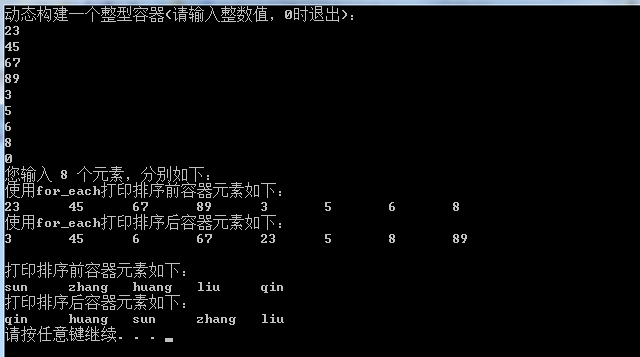
3.3 sort函数也要求容器支持随机访问,该函数有两个版本:
第一个版本接受两个定义区间的迭代器参数,并使用为存储在容器中的类型元素定义的<运算符。
备注:如果元素为用户自定义类型,必须定义能够处理该类型对象的operator<()函数),对区间中的元素进行操作。
第二个版本接受3个参数,前两个参数也是指定区间的迭代器,最后一个参数是指向要使用的函数的指针(而不是比较的operator<()运算符)。
sort函数的应用示例代码如下:
#include <iostream>
#include <vector>
#include <string>
#include <algorithm> // for_each
using namespace std; template<class T>
void printVectorValue(T & rInt)
{
cout << rInt << "\t";
} struct student
{
string strName;
int nAge; student(string sName = "liu", int nAge = ) : strName(sName), nAge(nAge)
{}
}; bool worseThan(const student & stuObject1, const student & stuObject2)
{
if (stuObject1.nAge > stuObject2.nAge)
{
return true;
}
else if (stuObject1.nAge == stuObject2.nAge
&& stuObject1.strName > stuObject2.strName)
{
return true;
}
else
{
return false;
}
} void printValue(const student & rStuObject)
{
cout << rStuObject.strName << " " << rStuObject.nAge << "\n";
} void main()
{
cout << "sort函数版本1测试程序:" << endl;
cout << "动态构建一个整型容器(请输入整数值,0时退出):\n";
vector<int> vMyInts;
int nTemp;
while (cin >> nTemp && nTemp != )
{
vMyInts.push_back(nTemp);
}
cout << "您输入 " << vMyInts.size() << " 个元素,分别如下: " << endl;
cout << "使用for_each打印排序前容器元素如下:" << endl;
for_each(vMyInts.begin(), vMyInts.end(), printVectorValue<int>);
sort(vMyInts.begin(), vMyInts.end()); // 版本1
cout << endl << "使用for_each打印排序后容器元素如下:" << endl;
for_each(vMyInts.begin(), vMyInts.end(), printVectorValue<int>); cout << endl << endl << "sort函数版本2测试程序:" << endl;
vector<student> vStudents;
vStudents.push_back(student("sun", ));
vStudents.push_back(student("zhang", ));
vStudents.push_back(student("huang", ));
vStudents.push_back(student("liu", ));
vStudents.push_back(student("qin", ));
cout << "使用for_each打印排序前容器元素如下:" << endl;
for_each(vStudents.begin(), vStudents.end(), printValue);
sort(vStudents.begin(), vStudents.end(), worseThan); // 版本2
cout << "使用for_each打印排序后容器元素如下:" << endl;
for_each(vStudents.begin(), vStudents.end(), printValue);
cout << endl;
system("pause");
}
程序运行结果如下:
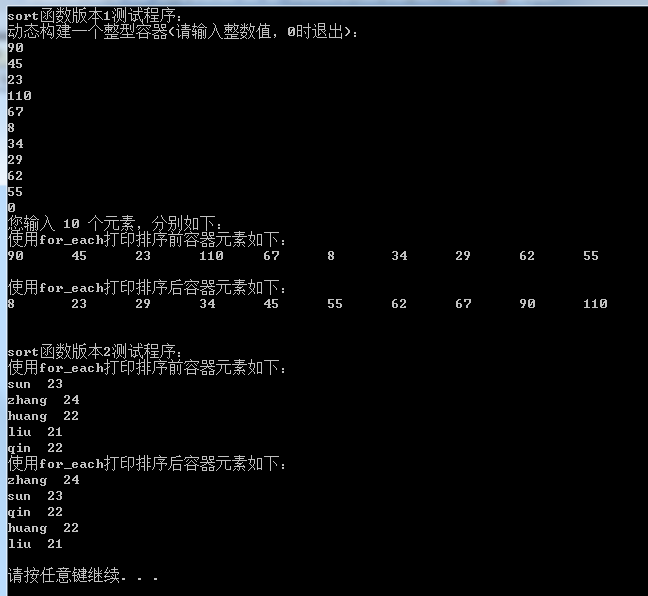
通用非成员函数结束。
【3】学习《STL源码剖析》中vector
(1)vector容器可以自动扩充内存空间,具体的扩充规则测试代码如下:
#include <vector>
#include <iostream>
#include <algorithm>
using namespace std; template<class T>
void printVectorValue(T & rInt)
{
cout << rInt << " ";
} template<class T>
void printSizeAndCapacity(vector<T> & oVec)
{
for_each(oVec.begin(), oVec.end(), printVectorValue<T>);
cout << endl << "size = " << oVec.size() << endl;
cout << "capacity = " << oVec.capacity() << endl << endl;
} int main()
{
vector<int> iv(, );
printSizeAndCapacity(iv);
for (int i = ; i < ; ++i)
{
iv.push_back(i + );
printSizeAndCapacity<int>(iv);
} system("pause");
}
vector容器示意图如下:
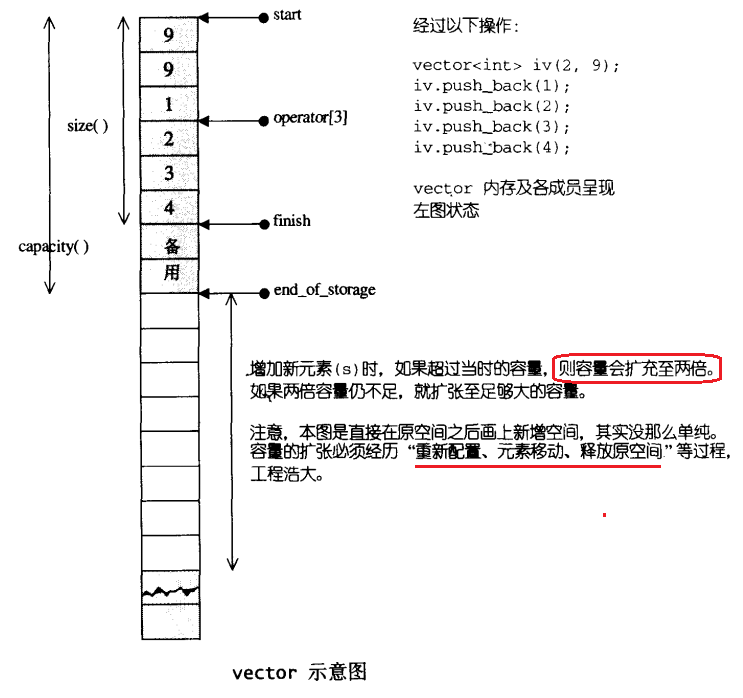
运行结果如下:
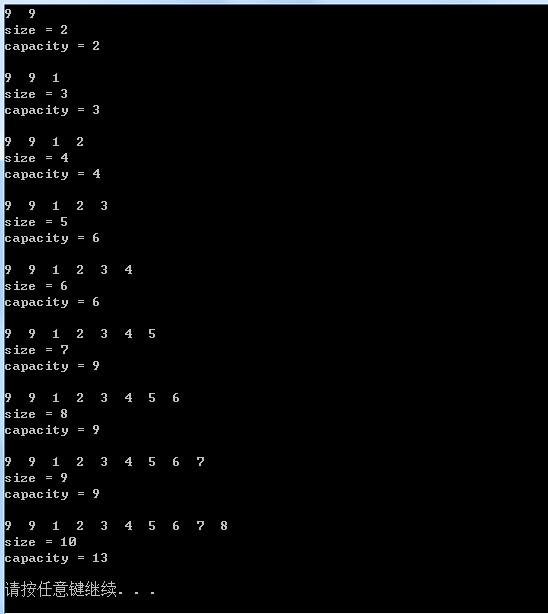
有一个遗留问题:如size不为零时,扩充后容量应该是之前的2倍,根据上例实际情况,不应该有奇数值的容量!求再探索,作此备录。
(2)vector迭代器和数据结构,如下图所示:

(3)vector部分源码如下:
#include<iostream>
#include<memory.h>
using namespace std; // alloc是SGI STL的空间配置器
template <class T, class Alloc = alloc>
class vector
{
public:
// vector的嵌套类型定义,typedefs用于提供iterator_traits<I>支持
typedef T value_type;
typedef value_type* pointer;
typedef value_type* iterator;
typedef value_type& reference;
typedef size_t size_type;
typedef ptrdiff_t difference_type;
protected:
// 这个提供STL标准的allocator接口
typedef simple_alloc <value_type, Alloc> data_allocator; iterator start; // 表示目前使用空间的头
iterator finish; // 表示目前使用空间的尾
iterator end_of_storage; // 表示实际分配内存空间的尾 void insert_aux(iterator position, const T& x); // 在position位置插入值为x的元素 // 释放分配的内存空间
void deallocate()
{
// 由于使用data_allocator进行内存空间的分配,
// 所以匹配使用data_allocator::deallocate()进行释放
// 如果直接释放, 对于data_allocator内部使用内存池的版本就会发生错误
if (start)
data_allocator::deallocate(start, end_of_storage - start);
} void fill_initialize(size_type n, const T& value)
{
start = allocate_and_fill(n, value);
finish = start + n; // 设置当前使用内存空间的结束点
// 构造阶段(不多分配内存)
// 所以要设置内存空间结束点(与已经使用的内存空间结束点相同)
end_of_storage = finish;
} public:
// 获取几种迭代器
iterator begin() { return start; }
iterator end() { return finish; } // 返回当前对象个数
size_type size() const { return size_type(end() - begin()); }
size_type max_size() const { return size_type(-) / sizeof(T); }
// 返回重新分配内存前最多能存储的对象个数
size_type capacity() const { return size_type(end_of_storage - begin()); }
// 判空
bool empty() const { return begin() == end(); }
// 重载[](下标访问)
reference operator[](size_type n) { return *(begin() + n); } // 默认构造函数。默认构造vector不分配内存空间
vector() : start(), finish(), end_of_storage() {} vector(size_type n, const T& value) { fill_initialize(n, value); }
vector(int n, const T& value) { fill_initialize(n, value); }
vector(long n, const T& value) { fill_initialize(n, value); } // 需要对象提供默认构造函数
explicit vector(size_type n) { fill_initialize(n, T()); } vector(const vector<T, Alloc>& x)
{
start = allocate_and_copy(x.end() - x.begin(), x.begin(), x.end());
finish = start + (x.end() - x.begin());
end_of_storage = finish;
} ~vector()
{
// 析构对象
destroy(start, finish);
// 释放内存
deallocate();
} vector<T, Alloc>& operator=(const vector<T, Alloc>& x); // 提供访问函数
reference front() { return *begin(); }
reference back() { return *(end() - ); } ////////////////////////////////////////////////////////////////////////////////
// 向容器尾追加一个元素, 可能导致内存重新分配(开辟新空间、移动原数据、释放原内存)
////////////////////////////////////////////////////////////////////////////////
// push_back(const T& x)
// |
// |---------------- 容量已满?
// |
// ----------------------------
// No | | Yes
// | |
// ↓ ↓
// construct(finish, x); insert_aux(end(), x);
// ++finish; |
// |------ 内存不足, 重新分配
// | 大小为原来的2倍
// new_finish = data_allocator::allocate(len); <stl_alloc.h>
// uninitialized_copy(start, position, new_start); <stl_uninitialized.h>
// construct(new_finish, x); <stl_construct.h>
// ++new_finish;
// uninitialized_copy(position, finish, new_finish); <stl_uninitialized.h>
//////////////////////////////////////////////////////////////////////////////// void push_back(const T& x)
{
// 内存满足条件则直接追加元素, 否则需要重新分配内存空间
if (finish != end_of_storage)
{
construct(finish, x);
++finish;
}
else
insert_aux(end(), x);
} ////////////////////////////////////////////////////////////////////////////////
// 在指定位置插入元素
////////////////////////////////////////////////////////////////////////////////
// insert(iterator position, const T& x)
// |
// |------------ 容量是否足够 && 是否是end()?
// |
// -------------------------------------------
// No | | Yes
// | |
// ↓ ↓
// insert_aux(position, x); construct(finish, x);
// | ++finish;
// |-------- 容量是否够用?
// |
// --------------------------------------------------
// Yes | | No
// | |
// ↓ |
// construct(finish, *(finish - 1)); |
// ++finish; |
// T x_copy = x; |
// copy_backward(position, finish - 2, finish - 1); |
// *position = x_copy; |
// ↓
// data_allocator::allocate(len); <stl_alloc.h>
// uninitialized_copy(start, position, new_start); <stl_uninitialized.h>
// construct(new_finish, x); <stl_construct.h>
// ++new_finish;
// uninitialized_copy(position, finish, new_finish); <stl_uninitialized.h>
// destroy(begin(), end()); <stl_construct.h>
// deallocate();
//////////////////////////////////////////////////////////////////////////////// iterator insert(iterator position, const T& x)
{
size_type n = position - begin();
if (finish != end_of_storage && position == end())
{
construct(finish, x);
++finish;
}
else
insert_aux(position, x);
return begin() + n;
} iterator insert(iterator position) { return insert(position, T()); } void pop_back()
{
--finish;
destroy(finish);
} iterator erase(iterator position)
{
if (position + != end())
copy(position + , finish, position);
--finish;
destroy(finish);
return position;
} iterator erase(iterator first, iterator last)
{
iterator i = copy(last, finish, first);
// 析构掉需要析构的元素
destroy(i, finish);
finish = finish - (last - first);
return first;
} // 调整size, 但是并不会重新分配内存空间
void resize(size_type new_size, const T& x)
{
if (new_size < size())
erase(begin() + new_size, end());
else
insert(end(), new_size - size(), x);
}
void resize(size_type new_size) { resize(new_size, T()); } void clear() { erase(begin(), end()); } protected:
// 分配空间, 并且复制对象到分配的空间处
iterator allocate_and_fill(size_type n, const T& x)
{
iterator result = data_allocator::allocate(n);
uninitialized_fill_n(result, n, x);
return result;
} // 提供插入操作
////////////////////////////////////////////////////////////////////////////////
// insert_aux(iterator position, const T& x)
// |
// |---------------- 容量是否足够?
// ↓
// -----------------------------------------
// Yes | | No
// | |
// ↓ |
// 从opsition开始, 整体向后移动一个位置 |
// construct(finish, *(finish - 1)); |
// ++finish; |
// T x_copy = x; |
// copy_backward(position, finish - 2, finish - 1); |
// *position = x_copy; |
// ↓
// data_allocator::allocate(len);
// uninitialized_copy(start, position, new_start);
// construct(new_finish, x);
// ++new_finish;
// uninitialized_copy(position, finish, new_finish);
// destroy(begin(), end());
// deallocate();
//////////////////////////////////////////////////////////////////////////////// template <class T, class Alloc>
void insert_aux(iterator position, const T& x)
{
if (finish != end_of_storage) // 还有备用空间
{
// 在备用空间起始处构造一个元素,并以vector最后一个元素值为其初值
construct(finish, *(finish - ));
++finish;
T x_copy = x;
copy_backward(position, finish - , finish - );
*position = x_copy;
}
else // 已无备用空间
{
const size_type old_size = size();
const size_type len = old_size != ? * old_size : ;
// 以上配置元素:如果大小为0,则配置1(个元素大小)
// 如果大小不为0,则配置原来大小的两倍
// 前半段用来放置原数据,后半段准备用来放置新数据 iterator new_start = data_allocator::allocate(len); // 实际配置
iterator new_finish = new_start;
// 将内存重新配置
try
{
// 将原vector的安插点以前的内容拷贝到新vector
new_finish = uninitialized_copy(start, position, new_start);
// 为新元素设定初值 x
construct(new_finish, x);
// 调整水位
++new_finish;
// 将安插点以后的原内容也拷贝过来
new_finish = uninitialized_copy(position, finish, new_finish);
}
catch(...)
{
// 回滚操作
destroy(new_start, new_finish);
data_allocator::deallocate(new_start, len);
throw;
}
// 析构并释放原vector
destroy(begin(), end());
deallocate(); // 调整迭代器,指向新vector
start = new_start;
finish = new_finish;
end_of_storage = new_start + len;
}
} ////////////////////////////////////////////////////////////////////////////////
// 在指定位置开始连续插入n个值为x的元素
////////////////////////////////////////////////////////////////////////////////
// insert(iterator position, size_type n, const T& x)
// |
// |---------------- 插入元素个数是否为0?
// ↓
// -----------------------------------------
// No | | Yes
// | |
// | ↓
// | return;
// |----------- 内存是否足够?
// |
// -------------------------------------------------
// Yes | | No
// | |
// |------ (finish - position) > n? |
// | 分别调整指针 |
// ↓ |
// ---------------------------- |
// No | | Yes |
// | | |
// ↓ ↓ |
// 插入操作, 调整指针 插入操作, 调整指针 |
// ↓
// data_allocator::allocate(len);
// new_finish = uninitialized_copy(start, position, new_start);
// new_finish = uninitialized_fill_n(new_finish, n, x);
// new_finish = uninitialized_copy(position, finish, new_finish);
// destroy(start, finish);
// deallocate();
//////////////////////////////////////////////////////////////////////////////// template <class T, class Alloc>
void insert(iterator position, size_type n, const T& x)
{
// 如果n为0,则不进行任何操作
if (n != )
{
if (size_type(end_of_storage - finish) >= n)
{ // 剩下的备用空间大于等于“新增元素的个数”
T x_copy = x;
// 以下计算插入点之后的现有元素个数
const size_type elems_after = finish - position;
iterator old_finish = finish;
if (elems_after > n)
{
// 插入点之后的现有元素个数 大于 新增元素个数
uninitialized_copy(finish - n, finish, finish);
finish += n; // 将vector 尾端标记后移
copy_backward(position, old_finish - n, old_finish);
fill(position, position + n, x_copy); // 从插入点开始填入新值
}
else
{
// 插入点之后的现有元素个数 小于等于 新增元素个数
uninitialized_fill_n(finish, n - elems_after, x_copy);
finish += n - elems_after;
uninitialized_copy(position, old_finish, finish);
finish += elems_after;
fill(position, old_finish, x_copy);
}
}
else
{ // 剩下的备用空间小于“新增元素个数”(那就必须配置额外的内存)
// 首先决定新长度:就长度的两倍 , 或旧长度+新增元素个数
const size_type old_size = size();
const size_type len = old_size + max(old_size, n);
// 以下配置新的vector空间
iterator new_start = data_allocator::allocate(len);
iterator new_finish = new_start;
__STL_TRY
{
// 以下首先将旧的vector的插入点之前的元素复制到新空间
new_finish = uninitialized_copy(start, position, new_start);
// 以下再将新增元素(初值皆为n)填入新空间
new_finish = uninitialized_fill_n(new_finish, n, x);
// 以下再将旧vector的插入点之后的元素复制到新空间
new_finish = uninitialized_copy(position, finish, new_finish);
}
# ifdef __STL_USE_EXCEPTIONS
catch(...)
{
destroy(new_start, new_finish);
data_allocator::deallocate(new_start, len);
throw;
}
# endif /* __STL_USE_EXCEPTIONS */
destroy(start, finish);
deallocate();
start = new_start;
finish = new_finish;
end_of_storage = new_start + len;
}
}
}
};
(4)使用主要问题及成员函数详解。
4.1 erase函数。vector::erase()方法有两种重载形式:
(1.1)iterator erase (iterator _Where);
(1.2)iterator erase (iterator _First, iterator _Last);
如果是删除指定位置的元素时:返回值是一个迭代器,指向删除元素下一个元素。
如果是删除某范围内的元素时:返回值也表示一个迭代器,指向最后一个删除元素的下一个元素。
请看如下“临床典型性”应用错误示例代码:
#include <vector>
#include <iostream>
#include <algorithm>
using namespace std; template<class T>
void printVectorValue(T & rInt)
{
cout << rInt << " ";
} void main()
{
vector <int> v1;
for (int i = ; i < ; ++i)
{
v1.push_back(i + );
}
cout << "(1) v1 容器元素如下:" << endl;
for_each(v1.begin(), v1.end(), printVectorValue<int>);
cout << endl; v1.erase(v1.begin( ));
cout << "(2) v1 容器元素如下:" << endl;
for_each(v1.begin(), v1.end(), printVectorValue<int>);
cout << endl; v1.erase(v1.begin( ) + , v1.begin( ) + );
cout << "(3) v1 容器元素如下:" << endl;
for_each(v1.begin(), v1.end(), printVectorValue<int>);
cout << endl; v1.push_back();
vector<int>::iterator itPt;
for (itPt = v1.begin(); itPt != v1.end(); ++itPt)
{
if ( == *itPt)
{
v1.erase(itPt);
}
} system("pause");
}
程序运行结果如下:

分析程序:一一遍历容器找到元素值为14,然后一一删除。程序为什么会崩溃呢?
其实,出现这种原因是没搞懂erase的删除原理(套路),当调用erase()后迭代器就失效了,即变成一个野指针。
所以要处理这种问题,关键是要解决调用erase()方法后,迭代器变成野指针的问题。
结合套路,解决这个问题有两种方案:
第一种:正向删除。
第二种:逆向删除。代码如下:
#include <vector>
#include <iostream>
#include <algorithm>
using namespace std; template<class T>
void printVectorValue(T & rInt)
{
cout << rInt << " ";
} // 正删
template<class T>
void eraseAll(vector<T> & v1, T value)
{
vector<T>::iterator itPt;
for (itPt = v1.begin(); itPt != v1.end();)
{
if (value == *itPt)
{
itPt = v1.erase(itPt);
}
else
{
++itPt;
}
}
} // 逆删
template<class T>
void eraseAll2(vector<T> & v1, T value)
{
vector<T>::iterator itPt;
for (itPt = --v1.end(); itPt != v1.begin();)
{
if (value == *itPt)
{
v1.erase(itPt--);
}
else
{
--itPt;
}
} if (value == *itPt)
{
v1.erase(itPt);
}
} void main()
{
vector<int> v1(, );
for (int i = ; i < ; ++i)
{
v1.push_back(i + );
}
cout << "(1) v1 容器元素如下:" << endl;
for_each(v1.begin(), v1.end(), printVectorValue<int>);
cout << endl; v1.erase(v1.begin( ));
cout << "(2) v1 容器元素如下:" << endl;
for_each(v1.begin(), v1.end(), printVectorValue<int>);
cout << endl; v1.erase(v1.begin( ) + , v1.begin( ) + );
cout << "(3) v1 容器元素如下:" << endl;
for_each(v1.begin(), v1.end(), printVectorValue<int>);
cout << endl; v1.insert(v1.begin() + , , );
v1.push_back();
v1.push_back();
cout << "(4) 删除前 v1 容器元素如下:" << endl;
for_each(v1.begin(), v1.end(), printVectorValue<int>);
cout << endl; // 第一种正向删除
eraseAll<int>(v1, );
eraseAll<int>(v1, );
eraseAll<int>(v1, ); /* 第二种逆向删除
eraseAll2<int>(v1, 9);
eraseAll2<int>(v1, 12);
eraseAll2<int>(v1, 15);
*/
cout << "(5) 删除9,12,15后 v1 容器元素如下:" << endl;
for_each(v1.begin(), v1.end(), printVectorValue<int>);
cout << endl;
/* 错误删除!!
for (itPt = v1.begin(); itPt != v1.end(); ++itPt)
{
if (14 == *itPt)
{
v1.erase(itPt);
}
}
*/ system("pause");
} // Run out
/*
(1) v1 容器元素如下:
9 9 9 9 9 9 10 11 12 13 14 15
(2) v1 容器元素如下:
9 9 9 9 9 10 11 12 13 14 15
(3) v1 容器元素如下:
9 9 9 10 11 12 13 14 15
(4) 删除前 v1 容器元素如下:
9 9 9 10 11 12 12 12 12 13 14 15 15 15
(5) 删除9,12,15后 v1 容器元素如下:
10 11 13 14
请按任意键继续. . .
*/
规避开失效指针,完全可以正常删除。
4.2 insert函数
insert函数源码如下:
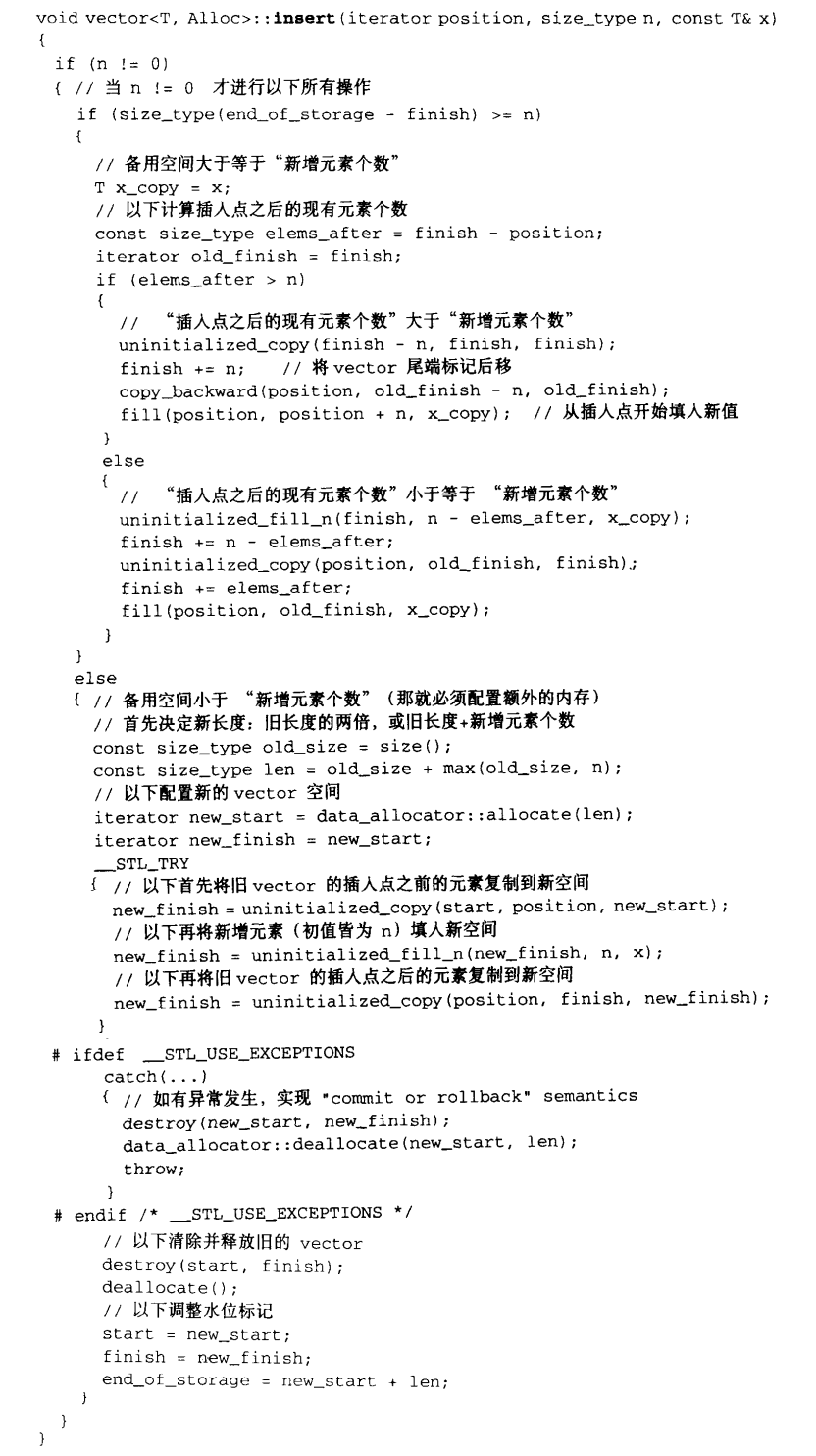
insert函数两种情况分析如下:
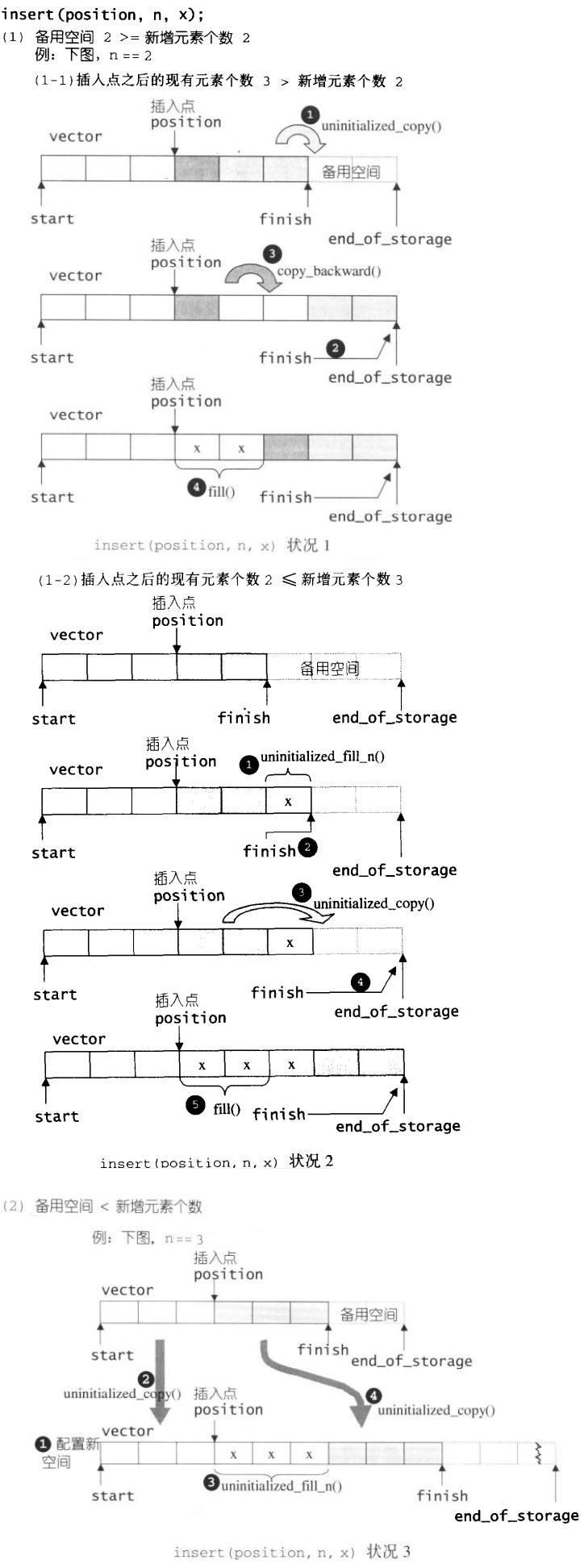
insert函数重载多,使用比较方便。
【4】vector总结
相比C++内置的array数组类,vector模板类是有生命的、动态的、可塑性的数组,使用更方便,更健壮。
Good Good Study, Day Day Up.
顺序 选择 循环 总结
STL容器之vector的更多相关文章
- [知识点]C++中STL容器之vector
零.STL目录 1.容器之map 2.容器之vector 3.容器之set 一.前言 关于STL和STL容器的概念参见STL系列第一篇——map(见上).今天介绍第二个成员——vector. 二.用途 ...
- [知识点]C++中STL容器之set
零.STL目录 1.容器之map 2.容器之vector 3.容器之set 一.前言 继上期的vector之后,我们又迎来了另一个类数组的STL容器——set. 二.用途与特性 set,顾名思义,集合 ...
- [知识点]C++中STL容器之map
UPDATE(20190416):写完vector和set之后,发现不少内容全部引导到map上了……于是进行了一定的描述补充与更正. 零.STL目录 1.容器之map 2.容器之vector 3.容器 ...
- 顺序容器之vector
最近因为需要,在看C++ primer,哇,感觉这本书真不错,讲的细而且到位,而且大量的练习题,不愧为C++学习的经典书籍.今天看了顺序容器方面的内容,现在汇报一下: 一.什么是vector vect ...
- C++STL模板库序列容器之vector
目录 STL之Vecter 一丶STL简介 二丶Vector用法 1.vector容器的使用 2.vector迭代器. 3.vector中的方法. 三丶常用算法 1.常见算法中的算法方法. 2.sor ...
- STL序列容器之vector
一,vector容器简介 1.vector容器的原理 vector是将元素置于一个动态数组中加以管理的容器. 2.vector容器的特点 vector容器可以随机存取元素,支持索引存取(即用数组下标的 ...
- C++ 序列式容器之vector
什么是容器 容器,顾名思义,是用来容放东西的场所.C++容器容放某种数据结构,以利于对数据的搜寻或排序或其他特殊目的.众所周知,常用的数据结构不外乎:数组array, 链表list, 树tree ...
- C++ STL容器之 stack
STL 中的 stack 是一种容器适配器,而不是一种容器. 它是容器适配器是指,只要支持一系列方法的容器(empty, size, back, push_back, pop_back),都能作为st ...
- C++容器之Vector
vector是C++标准模板库中的部分内容,它是一个多功能的,能够操作多种数据结构和算法的模板类和函数库.vector之所以被认为是一个容器,是因为它能够像容器一样存放各种类型的对象,简单地说vect ...
随机推荐
- 20165336 2017-2018-2《Java程序设计》第6周学习总结
20165336 2017-2018-2<Java程序设计>第6周学习总结 教材学习内容总结 常量池中的数据在程序运行期间再也不允许改变. String s = new String(&q ...
- swift 的相机扫描
func scaning(){ //获取摄像设备 guard let device = AVCaptureDevice.default(for: .video) else { return } //输 ...
- There are 0 datanode(s) running and no node(s) are excluded in this operation.
向hadoop导入文件,报错 .... There are 0 datanode(s) running and no node(s) are excluded in this operation. . ...
- Linux dmidecode 命令
当我们需要获取机器硬件信息时,可使用linux系统自带的dmidecode工具进行查询. dmidecode 用于获取服务器的硬件信息,通常是在不打开计算机机箱的情况下使用该命令来查找硬件详细信息 这 ...
- vs2015智能提示英文改为中文
vs2015智能提示英文改为中文 C:\Program Files (x86)\Reference Assemblies\Microsoft\Framework\.NETFramework 进入 \v ...
- 微信小程序可以转发给微信好友了
微信小程序又放大招了:小程序页面可以放置转发按钮,分享更流畅.同时开放了微信运动步数.背景音乐播放等更多基础能力.小程序可以在自己的页面上放置转发按钮,用户点击后,即可将喜欢的内容分享给好友或群聊,体 ...
- gh-ost:不一样的在线表结构变更
简介: 2016年8月份,shlomi-noach在GitHub Engineering发文宣布gh-ost开源.gh-ost是什么?一个不依赖触发器实现的在线表结构变更工具. 对于数据库运维人员来说 ...
- 【LDA】周志华
一.书籍
- RN-系列
8081端口被占用,McAfee Agent关不掉 sudo lsof -n -i4TCP:8081 sudo launchctl list | grep 5693 sudo launchctl re ...
- 虚拟主机是设置在httpd-vhosts.conf还是vhosts.conf还是httpd.conf
https://blog.csdn.net/weisubao/article/details/43536723 解决方案:虚拟主机是设置在httpd-vhosts.conf还是vhosts.conf还 ...
